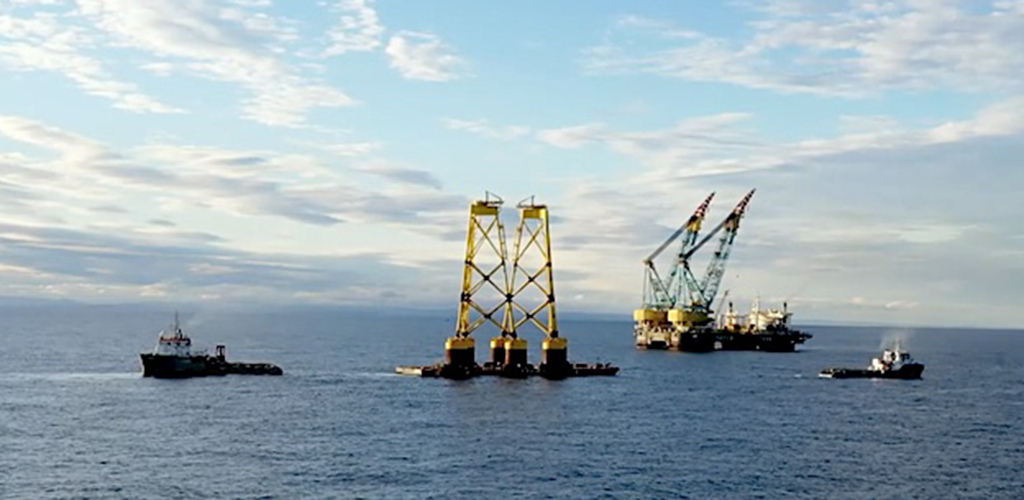World’s Deepest, Fixed-bottom Offshore Wind Farm

Construction of the 1.1-gigawatt Seagreen project, the world’s deepest, fixed-bottom offshore wind farm, progressed this month with installation of the first turbine jacket foundation.
It is the largest wind farm project in Scotland and is expected to deliver a number of engineering firsts during the installation process.
Lloyd Duthie, managing director for EPCI Projects at Seaway 7 called the move a "momentous milestone," adding that the jacket installation campaign will continue “through 2021 and 2022 as we lay Seagreen’s foundations.”
Landmark Delivery
The giant foundation pieces were delivered by barge from the north of Scotland to the site, more than 180 kilometers away. Weighing 2,000 tonnes each, the jackets were prepared at the Port of Nigg, near Tain, and bases were brought to Port of Dundee while the barge was readied for offshore installation.
“It is testament to the skill of our project team and all our contractors including our Scottish and UK supply chain that we have been able to get to this landmark point,” said Paul Cooley, director of capital projects at SSE Renewables.
Located 27 kilometers off the coast of Angus Council in the east of Scotland, the Seagreen project is a £3 billion joint venture between SSE Renewables and TotalEnergies.The partners have appointed Norway-based Seaway 7 as the main contractor for the project and aim to deliver first power by early 2022, following installation of 114 wind turbine foundations, with transport ongoing from Nigg to the project site.
Energy Park Investment
Global Energy Group, the operator of the Port of Nigg, has invested heavily in upgrades at the port to handle breakbulk pieces of this magnitude, and Tim Cornelius, CEO noted the "significant contributions" of everyone involved. "We are delighted to be supporting the storage and marshalling activities for the Seagreen project at the Port of Nigg … It is major projects like this which will help the Scottish supply chain benefit from efforts to decarbonize our energy market in the UK.”
Alongside expansion of the port of Nigg, Global Energy has also built new quayside at the nearby Port of Cromarty Firth in Invergordon and estimates total investment across both ports to be more than £100 million by 2023. Global Energy appointed Cornelius as its new chief executive in January.
To deliver the remaining jackets, several barges will work in continuous rotation, carrying jackets in sets of two from Nigg to the wind farm, in a journey lasting approximately 36 hours dependent on weather.
“More than 50 people are involved each time the barges head out to site including the on-shore team, ballast engineer, tug captain, crew, riggers, welders, tow master and pilot,” a spokesperson for SSE Renewable said.
Advanced Engineering
Upon arrival at the project site, the first jacket foundations were met by the semi-submersible crane vessel, Saipem 7000, which will install all 114 units.
The deepwater project will involve advanced techniques and will be the first-ever gigawatt-scale use of suction caisson technology to fix offshore wind turbine foundations to the seabed. This technique utilizes an open-bottomed tube, embedded in the sediment and sealed at the top, to act as a fixed platform anchor and redirect lifting forces, generating a pressure differential to hold the caisson down.
Praising the hard work of “the thousands of people bringing Seagreen to life across the supply chain” and the speed of delivery “only 16 months after contract award,” Duthie of Seaway 7 said cable lay vessels will start the installation of the inner array grid cables later this year.
“These cables will connect the network of turbines and transport future electricity generated by the wind turbines to the offshore substation – ready for transport onshore,” Duthie said.
Once installed, each jacket foundation will hold a Vestas V164-10 MW turbine. Equipped with three blades, each weighing 35 tonnes, the turbine measures 164 meters in diameter. The nacelle weighs a further 390 tonnes and supports a swept area of 21.1 square meters.
More than 5,00 kilometers away in the UAE, a further milestone was reached in the Seagreen project when EPC firm Petrofac completed load out of the High Voltage Alternating Current (HVAC) offshore substation platform jacket and piles for the project.
Describing the "unprecedented challenge" that fabrication and delivery of this giant structure required, Vipul Sawe, senior project director at Petrofac, said: “it was about being flexible and finding solutions for any situation … it’s very rewarding to work on something from the very beginning as I have with Seagreen.”
The giant superstructure was loaded at Eversendai Offshore’s facility in the UAE and will sail to Scotland aboard the heavy-load carrier, Dongbang Giant No: 8.
Accelerated Energy Transition
As well as the largest offshore windfarm in Scotland, the Seagreen project is also one of the largest construction projects ever undertaken in the country and has received strong support from the Crown Estate, which leases the land.
Colin Palmer, director of marine for Crown Estate Scotland, called the project “an extremely important development” in the expansion of the Scottish offshore wind sector, and a key element in achieving “a net-zero future for the country which comes just weeks prior to Scotland playing host to the COP26 summit in Glasgow.”
When the site is completed, operations and maintenance will be carried out from Montrose Port, which will be home to up to 120 full-time operational roles including up to 60 Vestas personnel.
Philippe De Cacqueray, head of offshore wind UK at TotalEnergies, predicts that this project will be the first of many large-scale wind developments in the country, noting that Scotland’s energy transition is “beginning to accelerate”, and adding “we have taken another important step towards the Net-Zero goal. TotalEnergies is delighted that Seagreen has now installed the first jacket at what will become Scotland’s largest offshore wind farm.”

